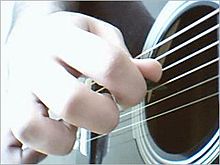Flatpicking: Difference between revisions
Pinethicket (talk | contribs) Undid revision 389546728 by 98.176.221.233 (talk)Rv--unsourced |
No edit summary |
||
| Line 1: | Line 1: | ||
{{worldwide}} |
|||
{{Unreferenced stub|auto=yes|date=December 2009}} |
{{Unreferenced stub|auto=yes|date=December 2009}} |
||
[[File:Playing guitar with pick.jpg|thumb]]'''Flatpicking''' is a technique for playing a [[guitar]] using a [[guitar pick]] (also called a [[plectrum]]) held between two or three fingers to strike the strings. It can be contrasted to [[fingerstyle guitar]], which is playing with individual fingers, with or without wearing [[fingerpick]]s. |
[[File:Playing guitar with pick.jpg|thumb]]'''Flatpicking''' is a technique for playing a [[guitar]] using a [[guitar pick]] (also called a [[plectrum]]) held between two or three fingers to strike the strings. It can be contrasted to [[fingerstyle guitar]], which is playing with individual fingers, with or without wearing [[fingerpick]]s. |
||
Revision as of 07:29, 21 October 2010
The examples and perspective in this article may not represent a worldwide view of the subject. |

Flatpicking is a technique for playing a guitar using a guitar pick (also called a plectrum) held between two or three fingers to strike the strings. It can be contrasted to fingerstyle guitar, which is playing with individual fingers, with or without wearing fingerpicks.
Although the term is used in other genres and with other instruments, it is probably best known in the context of playing an acoustic guitar with steel strings, particularly in bluegrass music and old-time country music. Probably starting around 1930, flatpicking was developed when guitarists began arranging old-time American fiddle tunes on the guitar, expanding the instrument's traditional role of rhythm guitar accompaniment with an occasional run on the bass strings.
The melodic style in bluegrass is often fast and dynamic, with slides, hammer-ons, pull-offs, powerful strumming and rapid crosspicking. Bluegrass flatpickers usually prefer guitars with a flat top rather than an arch top, and steel strings rather than nylon. The archetypal flatpicking guitar is the 'Dreadnought' series made by C.F. Martin & Company.
Early Styles
The chief proponents of the early country and bluegrass styles included Riley Puckett, George Shuffler, Alton Delmore, Don Reno and Bill Napier. The lead guitar was sparsely used, and sometimes was considered a novelty. Other instruments may also be used in flatpicking, such as the mandolin. There are banjo styles other than bluegrass such as the plectrum or tenor tuned banjos which can be played either by strumming or flatpicking. This style can be typified by players such as Eddie Peabody. and has connections to ragtime and dixieland music.
1960s
The foundation of Puckett, Reno and others were built upon heavily in the 1960s by Doc Watson and the late Clarence White. Watson and White both legitimized the acoustic guitar as a lead instrument in bluegrass and old-time country music. White brought guitar flatpicking to the forefront of bluegrass, while Watson brought flatpicking to folk audiences as he played fiddle tunes, blues, country, and gospel songs throughout America.
1970s-1980s
Building on the contributions of Doc Watson and Clarence White, artists such as Norman Blake, Dan Crary, John Carlini, Mark O'Connor, Russ Barenberg, Larry Sparks, and Tony Rice further developed the art of flatpicking. Rice likely had the most profound impact on bluegrass guitar playing of anyone since his musical hero, Clarence White. Rice's tone, rhythm, phrasing, and improvisational skills have influenced an entire generation of bluegrass guitarists. Important elements Rice has used in his playing are jazz type chord substitutions, different from the straight major and minor chords common to bluegrass, and the use of the Dorian mode and the minor pentatonic "blues" scale in his lead playing. While there have been several songs using the Dorian mode in Appalachian roots music, Rice made a different statement by using this scale to improvise during songs written in a major key. For instance, he is very well known for playing an F major scale during a song written in G major (the F major scale, when played from G to G, is a G Dorian mode). The use of this technique introduces the flat 3rd (Bb) and the flat 7th (F) over the G chord which has a unique sound popular to Bluegrass.
1990s-2000s
In more recent years, players such as David Grier, Bryan Sutton and Tim Stafford have carried the guitar into the next millennium. Also, current "young guns" like Cody Kilby, John Chapman, Chris Eldridge, Andy Falco, Dan O'Callaghan and Sean Watkins continue to explore this style of guitar playing. These players are still defining new standards and reaching wider audiences. Pioneers Rice, Blake, Barenberg, Crary, and Watson continue to produce music featuring flatpicking as well.
The annual National Flatpicking Championship is held at the Walnut Valley Festival in Winfield, Kansas.
See also
Flatpicking styles
- Alternate picking
- Crosspicking
- Downpicking
- Economy picking
- Hybrid picking
- Lead guitar
- Sweep-picking
- Tremolo picking
